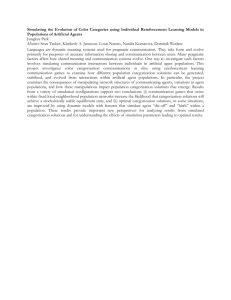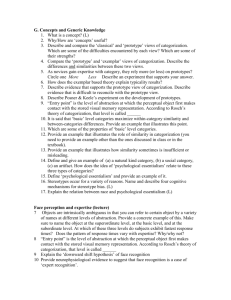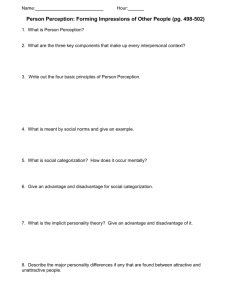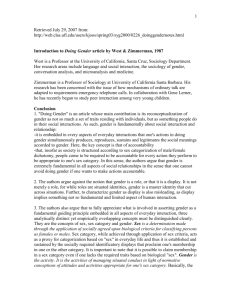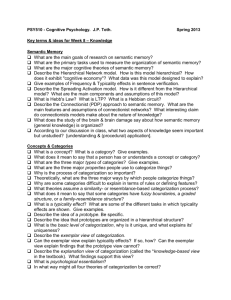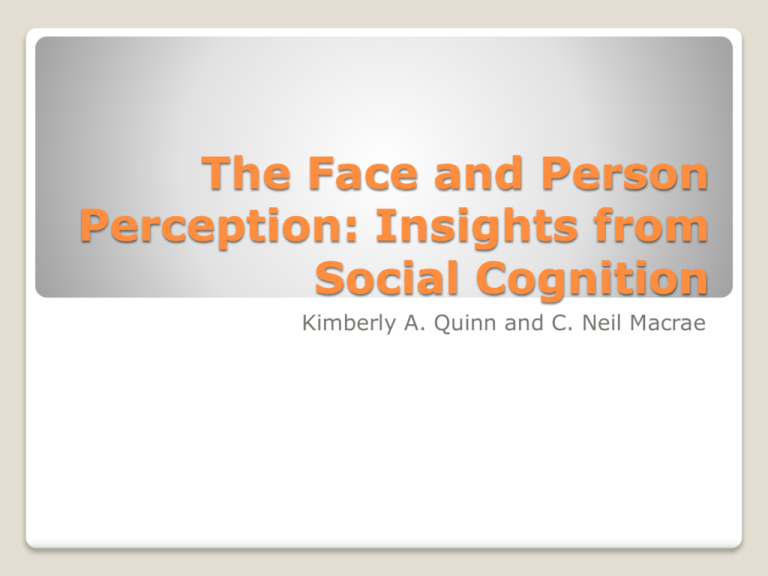
The Face and Person
Perception: Insights from
Social Cognition
Kimberly A. Quinn and C. Neil Macrae
I.
II.
III.
IV.
V.
Foundation of the study
Social-cognitive dynamics of face
perception
Processing multiple social-category cues
The categorization–identification
interface
Conclusion and Discussion
Contents
Understanding the dynamics of social
categorization
Considering visual processing (bottom-up
process) and semantic knowledge (topdown process) for understanding in face
perception
Derived from Bruce and Young (1986)
dual route model
I. Foundation of the study
Reminder of Bruce & Young theory
Debate of identity-nonspecific information’s
role, and previous studies showed:
a. Dissociation between abstract generic
information from faces and face recognition
b. Integrated processing of identity-specific
and -nonspecific information
c. Explain where visually derived semantic
codes related to identity-nonspecific
information, and how extra-facial factors
influence face processing -> socialcognitive perspective
Main Focus
Social perceivers automatically and inevitably
perceive others according to visible
dimensions such as sex, race, and age
(Fiske, 1998)
Brewer’s (1988) dual-process model:
perceivers choose implicitly between
stereotyping and individuation
Fiske and Neuberg’s (1990) continuum
model: priority to stereotyping and depicting
individuation as a correction process
II. Social-cognitive dynamics
of face perception
Brewer’s model (1988) primitive
categorization
Fiske and Neuberg’s (1990) initial
categorization
Emphasize social categorization of faces.
Social-cognitive models person
perception rather than face recognition,
and primarily to the construal of
unfamiliar rather than familiar individuals.
These models assumed stereotyping
sufficient for identity-specific information,
therefore identity-non specific information
processing is not needed.
Three experiments from Quinn and Macrae
(2005)
Experiment 1: showed social categorization
need an appropriate processing goal
Experiment 2: if perceiver didn’t categorize
stimuli, the reaction times won’t be differ
between repeated and new stimuli
Experiment 3: the efficiency of sex
categorization depended on the age of a
target, but age categorization was not
influenced by variation in target sex.
III. Processing multiple socialcategory cues
Single category selection
Perceiver using relevant dimension and
inhibit irrelevant ones.
Quinn and Macrae (2005) second
experiment.
Stereotype activation is also selective.
Challenge on finding: Wiese, Schweinberger,
and Neumann (2008) recently reported ERP
version of Quinn and Macrae’s multiplecategory repetition-priming experiment.
a.
b. Multiple-category integration
Quinn & Macrae’s third experiment
Freeman et.al easy and difficult-tocategorize faces’ task
c. Integrating processing of socialcategory cues and other social cues
cues to differentiate sex (facial features
and specific facial expression)
Male
angry
Female
fear
gaze direction and emotional expression
There is still debate
Happy direct
gaze
Fear averted
gaze
race categorization and emotional
expression
Anger expression
identified faster in
African people
Happy expression
identified faster in
Caucasian
Voice Cues
Raki´c, Steffens, and Mummendey
(2011), who used a ‘who said what?’
paradigm
to examine the separate and combined
influences of voice and facial cues in
person perception
Contextual
cues
Perceivers do not categorize by race when
another dimension of categorization is
more useful in the ongoing context.
Example: T-shirt colour denoted
coalitions that race did not.
Social-cognitive evidence thus suggests
that the processing of identity-nonspecific
information in faces is extremely flexible
and responsive to such factors as
processing goals, semantic knowledge,
and contextual cues.
a.
Social categorization influences identity
recognition
‘cross-race’ or ‘other-race’ effect.
social categorization also plays a critical role in
shaping own- and other-race face processing.
Other race identity recognition could also be
sensitive to social categorization (making ingroup and out-group)
Social categorization can even affect how
individual features are perceived.
Emotional recognition
IV. The categorization–
identification interface
b. Identity recognition influences social
categorization
it is easier to extract categorical
information from known versus unknown
faces.
before a perceiver can recognize a target’s
unique identity, the target’s face must first
receive basic visual processing.
primacy of categorical thinking
Identity recognition appears to be heavily
reliant on the extraction of configural
information across multiple features
Categorization vs identification
Quinn, Mason, and Macrae (2010) used
automatic priming paradigm to investigate
whether and when participants would
automatically respond to unfamiliar and
familiar others according to identity
versus social category
Emphasis on the processing of identitynonspecific (primarily social-category)
information.
The contribution of social cognition face
perception is twofold.
a. social categorization
b. importance of extra-facial (prejudice)
V. Conclusion
A comprehensive account of face perception
requires, at minimum, the consideration of
three issues.
a. Model should specify whether and how
various forms of identity-specific and nonspecific information are integrated
b. Specify the downstream consequences of
such integration
c. Make clear the nature and extent of online
feedback from long-term memory during face
processing.
Which social categorization needed or
automatically came out when we’re
looking at a person?
Procedures and results in Quinn and
Macrae’s study should be explained in
more details.
Discussion


